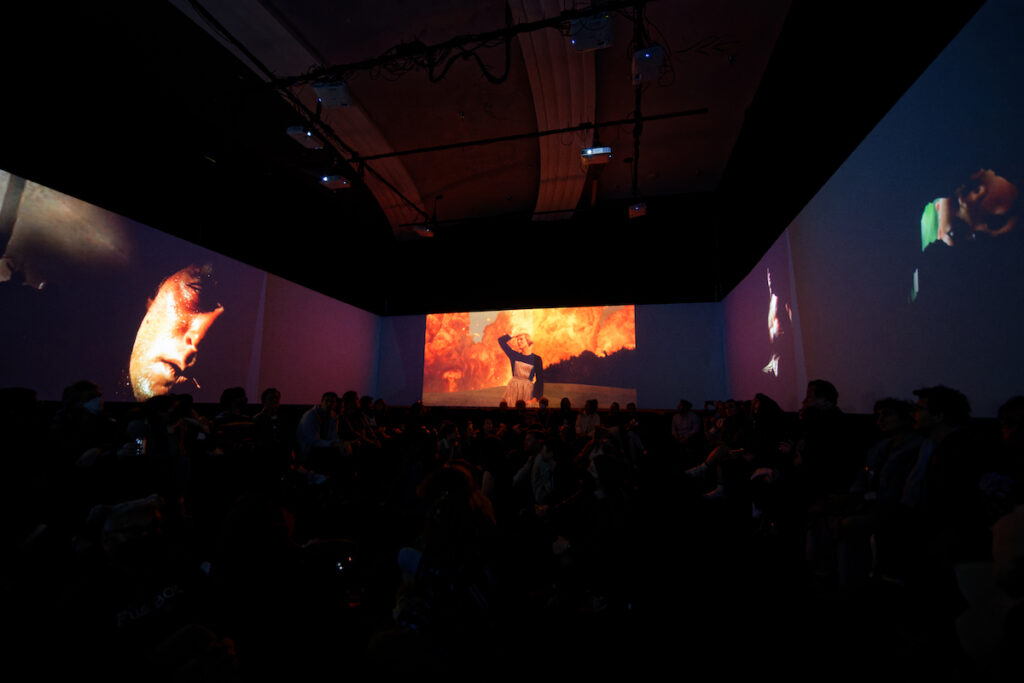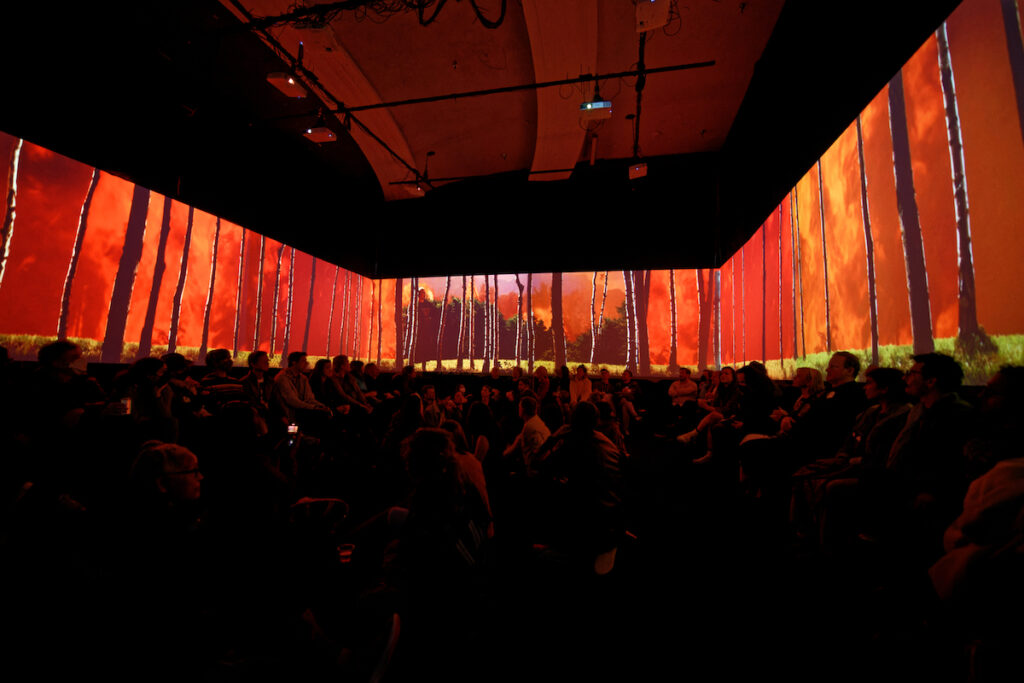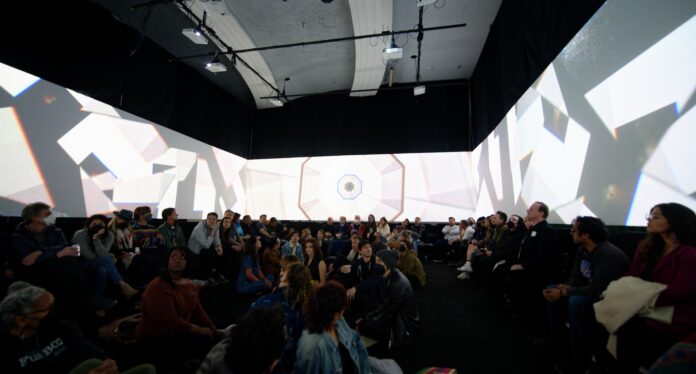Recombinant Media Lab’s CineChamber, Gray Area Foundation for the Arts, and art project People Like Us are presenting the US premiere of immersive multimedia work Gone, Gone Beyond (through May 27). All three aim to create a space for exploring art, technology, and society in novel ways.
Gone, Gone Beyond and the CineChamber stand in stark contrast to an early artistic foray into virtual reality: “Euphor!um,” Antenna Theatre’s rendition of Coledridge’s “Kubla Khan” that ran in San Francisco in 2001. Then, participants wore almost unwieldy headsets (really, large boxes), and were guided from room to room as a way to experience Coleridge’s opium-inspired poem through images and sounds. It was a novel, immersersive experience for the early aughts.
Today, the CineChamber, brainchild of Naut Humon, offers a rectangular space surrounded by 10 screens and an eight-channel speaker system designed so artists can integrate sound and image to explore their own “discovery threads.” To Naut Humon, CineChamber represents a “VR mindset without the headset” and serves as a “motion canvas” for artists to push the integration and evolution of physical space and media arts. Humon sees his role as a curator who forms relationships with artists to help them manipulate the CineChamber as a context for their content. Creators use their artifacts to tell stories—an artistic version of historiography Humon calls a “WRECKROSPECTIV.”

Naut Humon and British artist Vicki Bennett’s People Like Us project collaborated extensively to bring Gone, Gone Beyond to fruition. Unlike the completely isolating experience of “Euphor!um,” in the CineChamber, audience members sit facing both a screen and each other so they are simultaneously watching Gone, Gone Beyond, catching glimpses and sounds of other audience members, and turning to see how the perspective on the screens differs. To begin, the audience walks up a ramp and selects seats, while images of candles flicker on the screens, and ambient sounds of crickets and other background noises meld with the sound of the audience chatting. To some, this is the waiting for the beginning; to others, the art has begun and the audience is providing an additional layer of sound.
As the candle flames burn out, images of portals and pathways centered in the surrounding screens are surrounded by samples of foreign and familiar movies and TV shows, until “It’s Time” is projected. For the next hour, Gone, Gone Beyond offers jarring juxtapositions and layers of images and sounds. Julie Andrews romping through the Austrian Alps singing “The hills are alive with the sound of music” partnered with Marlon Brando in a freshly napalmed Vietnamese Jungle in Apocalypse Now. As Andrews tosses stones into an idyllic pond, the sound of bombs dropping replace the gentle splash of stones and The Doors’ “The End” plays.
The frenetic pace of the piece offers recurring visual and auditory motifs: portals, doors, pathways; beacons, lightning, flames, the northern lights; eyes and mirrors; circles, orbs, clockworks. The repetition of the Christmas Carol lyric “Do you see what I see” has an obvious answer of “no” as depending on where one sits, one’s visual experience is different. While our brains find some comfort in these patterns, we also grapple with the visual oxymora: fire in the ocean, 2001: A Space Odyssey next to Planet of the Apes, flowers blooming in the water. Periodically, silence and blank screens fill the room providing a brief interlude allowing the audience to exhale and spend a few minutes processing the previous sounds and images. As the entire experience draws to a close, the screen announces: “It’s Time/That stops us.”

According to People Like Us, the title Gone, Gone Beyond “comes straight from the Buddhist Heart Sutra. Which hints at formlessness and emptiness, which is not the same as nothing.” In Gone, Gone Beyond the compilation of images and sounds manifests this idea of formlessness by presenting these clips in novel context. A single whirling dervish (or perhaps a group) are replicated and layered; a carousel, ferris wheels, a kaleidoscope of images, a kaleidoscope of eyes even synchronized swimmers all suggest the Buddhist circle of life, death, rebirth, and suffering. The images depict humans trying to reach out, to understand, to make meaning, but connection and clarity seem elusive and transitory. Using chiaroscuro, momentary flashes of light followed by darkness convey our fleeting moments of understanding.
We are also keenly aware of the audience around us: the viewer filming while watching, the couple adjusting the plastic take out bag, the photographer moving around the room. This blurring of art and audience is intentional. To People Like Us “…it’s totally all right to admit that you are not an island in terms of receiving and transmitting ideas, which are impressions that for a temporary period visit us and change us, then others.”
The space and work itself, as well as the entire the experience offers layers: Participants can just go to experience Gone, Gone Beyond and the CineChamber, or they can “go beyond” and ponder the heart sutra, art, metaphysics, or how they themselves might create something in the audacious space.
GONE, GONE BEYOND runs through May 27 at Gray Area Gallery, SF. More info here.






